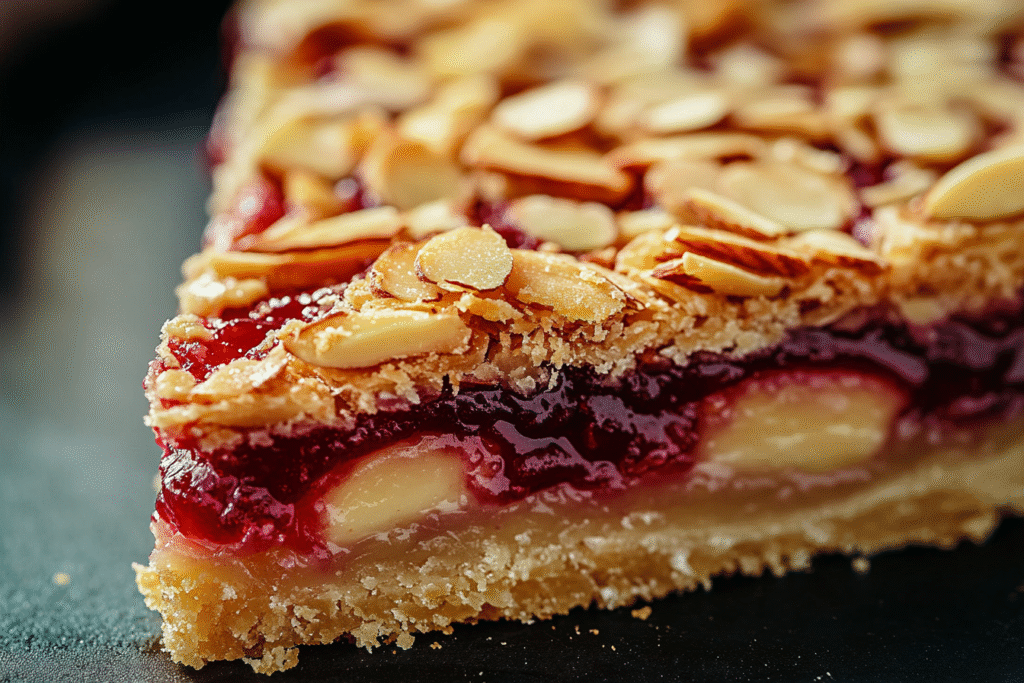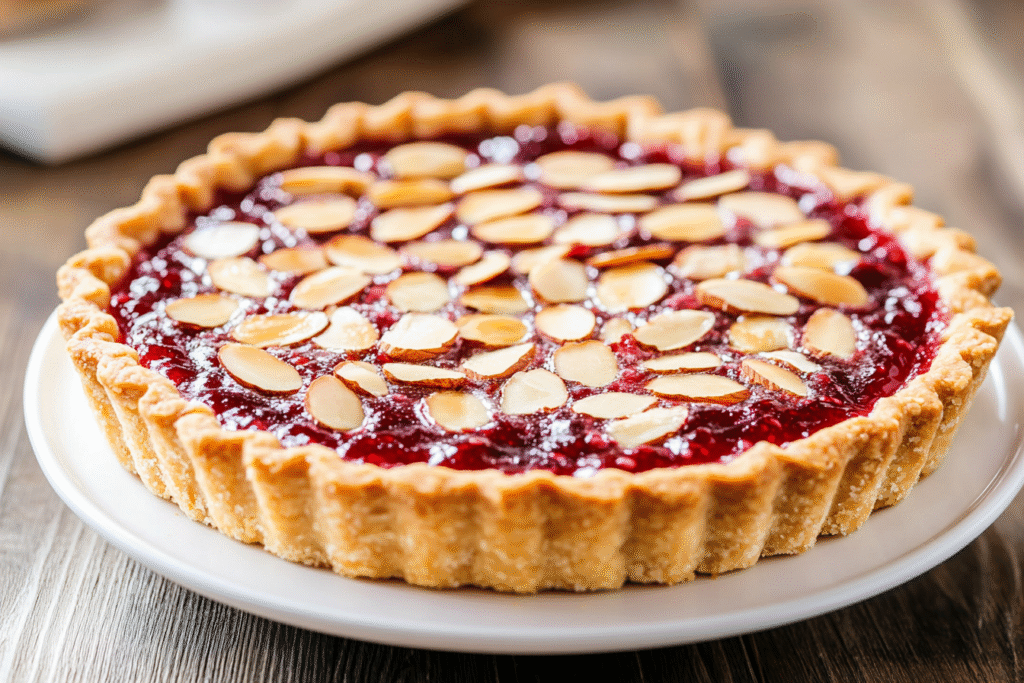Why the Bakewell Tart Is a Timeless British Bake
The Bakewell tart is the kind of dessert that manages to be both elegant and comforting — a true British classic that’s as satisfying to make as it is to eat. With its crisp, buttery shortcrust pastry, thin layer of tart raspberry jam, and light, nutty almond frangipane filling, it strikes a beautiful balance of textures and flavors in every bite. Crowned with a scattering of toasted almonds or a layer of icing (depending on tradition), it’s a versatile tart that feels right at home at afternoon tea or as a dinner party dessert.
Originating from the Derbyshire town of Bakewell, this iconic tart has evolved over centuries — often confused with its rustic cousin, the Bakewell pudding. But the modern tart we know today is defined by its structured shortcrust shell, smooth frangipane, and jewel-toned jam base. While it looks sophisticated, it’s surprisingly easy to make with the right steps, and it rewards attention to detail with rich almond aroma, a delicate crumb, and a lovely visual finish.
Whether you’re new to traditional British baking or a seasoned home baker, this guide will walk you through the process with practical tips, troubleshooting advice, and plenty of options for variations and presentation.
Understanding the Layers: What Makes a Bakewell Tart
The Bakewell tart has three distinct components, each bringing texture and flavor contrast:
1. The Shortcrust Pastry
A crisp, buttery pastry base made with flour, butter, and a touch of sugar. It’s blind-baked to ensure a firm structure that won’t become soggy once filled.
2. The Jam Layer
A thin spread of raspberry jam (traditionally) brings fruity brightness and a slight tang that offsets the richness of the frangipane. You can substitute other flavors, but raspberry is the classic.
3. The Frangipane Filling
An almond-based sponge made with ground almonds, sugar, eggs, and butter. It bakes up light and moist, yet set — a perfect contrast to the crisp shell and sticky jam.
Optional toppings include flaked almonds or a layer of white icing with a feathered cherry-red design — both widely accepted depending on whether you prefer your tart “iced” or “rustic.”

Choosing the Right Ingredients
This recipe relies on a handful of high-quality ingredients — each playing a key role in flavor and texture.
Flour
Use plain/all-purpose flour for the pastry. Avoid self-raising flour, which can puff too much and disrupt the tart structure.
Butter
Use unsalted European-style butter (high butterfat) if possible, especially for the pastry — it makes a flakier, richer crust and a more flavorful frangipane.
Almonds
Ground almonds (aka almond meal) form the base of the frangipane. They give moisture, structure, and that distinctive nutty taste. Don’t substitute almond flour unless you’re adjusting liquid quantities — almond flour is finer and can change texture.
Jam
Seedless raspberry jam is the traditional choice — tart, sweet, and smooth. You can use homemade or store-bought, but avoid overly sugary varieties.
Eggs
Use room temperature eggs to help the frangipane emulsify and rise evenly.

Tools You’ll Need
You don’t need fancy gear to make a Bakewell tart, but a few essentials will help:
- 9-inch (23cm) tart tin with removable base
- Mixing bowls
- Pastry cutter or food processor (for the dough)
- Rolling pin
- Parchment paper
- Baking weights or dried beans (for blind baking)
- Offset spatula or spoon (for spreading jam and frangipane)
- Cooling rack
Optional: piping bag for icing, small knife or skewer for feathering design.
Step-by-Step Pastry Perfection
The key to a good tart is a crisp base that doesn’t turn soggy under the filling. Here’s how to get it right:
- Chill the dough twice: Once after making, and again after lining the tin.
- Blind bake: Line with parchment and fill with baking weights to keep the crust from puffing up.
- Cool completely before filling: This ensures your jam doesn’t melt into the pastry and create a wet layer.
To Ice or Not to Ice? Traditional Topping Options
There are two accepted finishes:
- Classic flaked almonds: Scattered on top of the frangipane before baking. They toast beautifully and give a golden, rustic look.
- Iced topping: A layer of white icing made with powdered sugar and water or lemon juice, feathered with raspberry or cherry icing. This version is more bakery-style and festive.
Both are traditional — it just depends on your aesthetic and sweetness preference.
Ingredients
For the Shortcrust Pastry
- 1 1/4 cups (160g) all-purpose flour
- 2 tbsp powdered sugar
- 1/4 tsp fine salt
- 1/2 cup (113g) unsalted butter, cold and cubed
- 1 egg yolk
- 1–2 tbsp cold water
For the Filling
- 1/2 cup (113g) unsalted butter, softened
- 1/2 cup (100g) granulated sugar
- 2 large eggs
- 1/2 tsp almond extract (optional but classic)
- 3/4 cup (75g) ground almonds
- 2 tbsp all-purpose flour
- 1/4 cup (80g) seedless raspberry jam
For the Topping (choose one)
Option 1 — Flaked Almonds:
- 1/4 cup (20g) flaked almonds
Option 2 — Icing:
- 1 cup (120g) powdered sugar
- 2–3 tsp water or lemon juice
- 2 tsp raspberry or cherry jam, thinned with water
Instructions
1. Make the Shortcrust Pastry
- In a bowl, whisk together flour, sugar, and salt.
- Cut in cold butter using a pastry cutter or fingertips until the mixture resembles coarse crumbs.
- Add egg yolk and 1 tbsp cold water. Mix just until the dough comes together, adding more water if needed.
- Form into a disk, wrap in plastic, and chill for at least 30 minutes.
2. Blind Bake the Crust
- Roll out chilled dough on a lightly floured surface to 1/8 inch thick.
- Line a 9-inch tart tin with the dough, pressing into corners and trimming excess.
- Prick the base with a fork and chill for 15 minutes.
- Preheat oven to 375°F (190°C).
- Line the pastry with parchment paper and fill with baking weights.
- Bake for 15 minutes, remove weights, and bake 5–7 minutes more until lightly golden.
- Let cool completely.
3. Make the Frangipane
- In a bowl, cream softened butter and sugar until light and fluffy.
- Beat in eggs one at a time, then almond extract if using.
- Stir in ground almonds and flour until smooth.
4. Assemble the Tart
- Spread raspberry jam evenly over the cooled tart base.
- Spoon frangipane filling over the jam and smooth the top.
- If using almonds, scatter flaked almonds on top.
5. Bake the Tart
- Bake at 350°F (175°C) for 30–35 minutes, or until golden and the center is just set.
- Cool in the pan for 10 minutes, then remove and cool completely on a rack.
6. Ice the Tart (if using icing)
- Stir powdered sugar with water or lemon juice until smooth and pourable.
- Spread icing over the cooled tart.
- Add lines of raspberry jam on top and feather with a skewer for a decorative finish.
- Let set before slicing.
Serving and Storage
- Serve at room temperature or slightly warm.
- Dust with extra powdered sugar for a rustic look.
- Pair with tea, coffee, or even a glass of sherry for an old-school British finish.
Storage:
- Store covered at room temperature for up to 3 days.
- Refrigerate if using dairy-rich icing, though it may affect texture.
- Freeze the un-iced tart for up to 2 months. Thaw and ice just before serving.
FAQs and Troubleshooting
Can I use store-bought pastry?
Yes — a shortcrust or sweet tart dough works. Just blind-bake as directed.
Why did my frangipane sink or split?
It may have been overmixed or overbaked. Mix until just combined, and don’t overcook.
Can I use different jam?
Yes — cherry, apricot, or blackberry all work well. Just keep the layer thin.
Can I make mini Bakewell tarts?
Absolutely! Use mini tart tins and reduce bake time by 5–10 minutes.
Variations and Flavor Twists
- Chocolate Bakewell: Add a thin layer of melted dark chocolate beneath the jam.
- Lemon Bakewell: Swap raspberry jam for lemon curd, and use lemon zest in the frangipane.
- Cherry Bakewell: Use cherry jam and add a glace cherry to each slice.
Delicately crisp on the outside, tender and nutty on the inside, the Bakewell tart is a beautiful representation of British baking tradition. Whether enjoyed as a teatime treat or dressed up with icing for special occasions, it’s a recipe that balances elegance with comforting familiarity — and deserves a permanent place in your baking repertoire.


